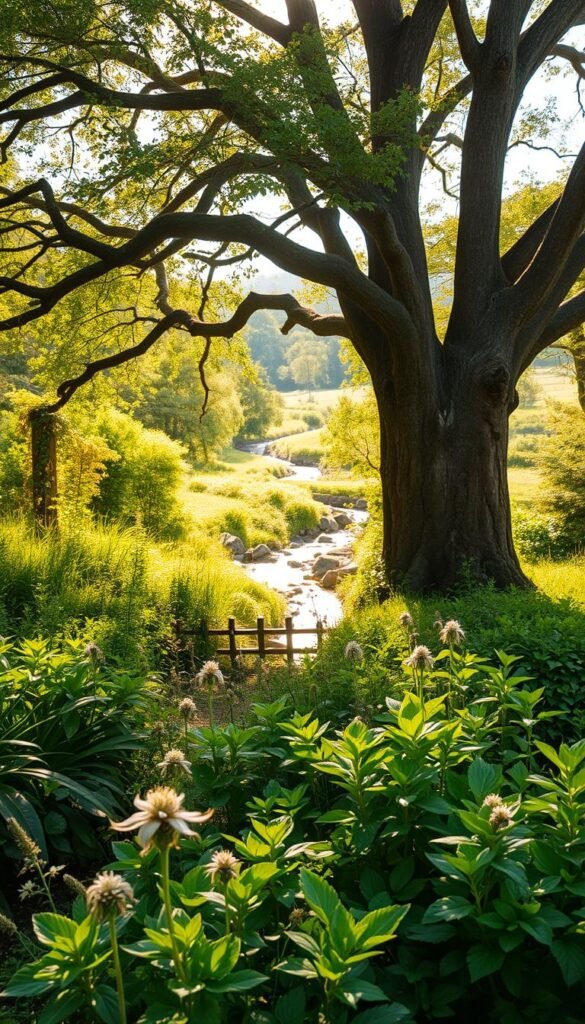Imagine stepping into your backyard and plucking fresh leaves for a calming tea or a salve to soothe minor cuts. A medicinal herb garden turns this vision into reality, offering nature’s remedies at your fingertips. Whether you’re new to gardening or have a green thumb, these plants thrive with minimal effort—no sprawling space required.
Herbs like lavender and chamomile aren’t just pretty additions to your yard. They’re powerhouses of wellness, addressing everyday needs from stress relief to digestive support. Growing them yourself ensures cleaner, fresher ingredients than store-bought options—plus, you’ll save money over time.
But here’s the best part: starting your own healing garden isn’t complicated. Many herbs adapt to pots, raised beds, or sunny windowsills. You’ll learn which varieties work best for your climate and how to harvest them for maximum potency.
Beyond practicality, tending these plants fosters a deeper connection to natural health. Each leaf you nurture becomes a step toward self-reliance, empowering you to care for your household in gentle, sustainable ways. Ready to transform that patch of dirt into a living pharmacy? Let’s begin.
Welcome to Your Medicinal Herb Garden Journey
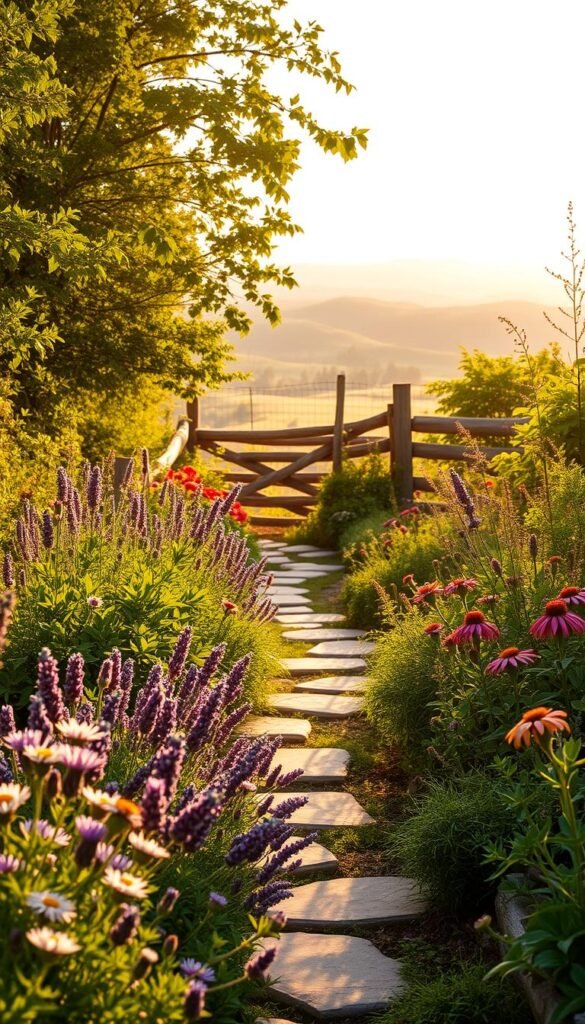
Growing therapeutic plants transforms your space into a sanctuary of wellness. It’s not just about dirt and seeds—it’s about cultivating resilience for your family’s health. Each leaf you grow becomes a bridge between modern life and ancestral wisdom.
Embracing the Healing Power of Plants
For centuries, communities relied on herbs as primary medicine. Today, planting peppermint or lemon balm connects you to this legacy. Digging your hands into soil reduces stress, while fresh harvests offer natural remedies.
Why Start a Medicinal Herb Garden?
Homegrown herbs ensure purity you can’t buy. Store shelves often hide additives or weak potency. With your own patch, you control quality and save money long-term.
| Benefit | Homegrown Herbs | Store-Bought Options |
|---|---|---|
| Freshness | Harvested same day | Weeks-old inventory |
| Cost | $0 after initial setup | $5-$15 per bottle |
| Customization | Grow what your family needs | Limited selections |
This journey in herb gardening builds confidence. You’ll learn to address headaches, cuts, or sleeplessness naturally. Plus, kids love snipping chamomile flowers for bedtime tea—a sweet way to teach self-care.
Understanding the Benefits and Uses of Medicinal Herbs
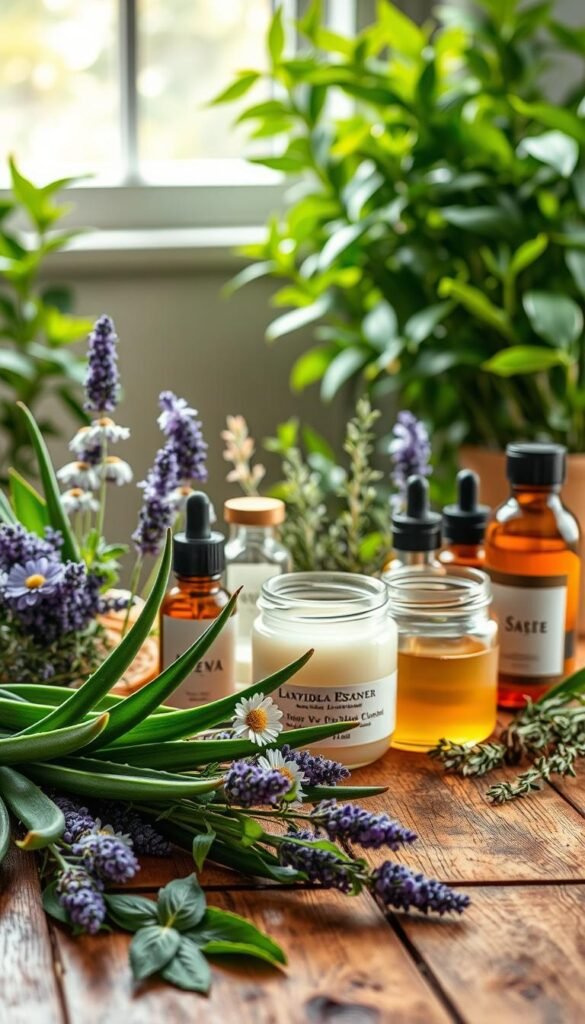
Your kitchen shelf might already hold secret healers waiting to bloom. Many everyday herbs multitask as gentle medicine, tackling everything from scraped knees to seasonal sniffles. Let’s explore how these green allies work with your body’s natural rhythms.
Skin Saviors and Stress Busters
Calendula’s bright orange petals pack a punch against irritated skin. Its anti-inflammatory oils speed healing for cuts, while antimicrobial properties fight minor infections. Keep a jar of infused oil handy for burns or diaper rash.
Chamomile does double duty—steep flowers for tummy-soothing tea or add to bathwater for frazzled nerves. One study found its vapor reduces cortisol levels by 47% in stressed adults.
Nature’s First-Aid Kit
Swap pharmacy runs for garden walks with these versatile remedies:
| Herb | Primary Use | Secondary Benefit |
|---|---|---|
| Garlic | Fights colds | Lowers blood pressure |
| Peppermint | Eases digestion | Clears sinus congestion |
| Lavender | Reduces stress | Repels mosquitoes |
Starting your gardening for beginners journey? Focus on 2-3 herbs your family uses most. Fresh peppermint in water cools summer heat, while garlic honey boosts winter immunity. Remember—herbs complement care but don’t replace doctors for serious concerns.
Planning Your Garden Space and Resources
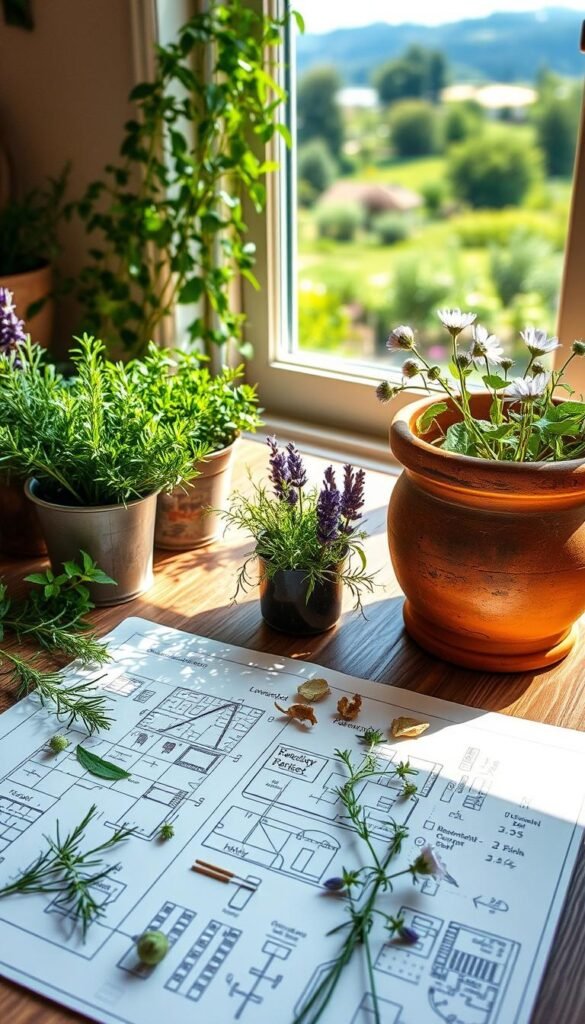
Transforming your outdoor area into a wellness hub starts with smart layout choices. Whether you’re working with acres or a balcony corner, strategic planning ensures your green allies flourish.
Choosing the Right Location and Soil
Most herbs demand 6-8 hours of direct sun daily. Walk your yard at different times to spot sunny patches. Avoid low areas where rainwater pools—soggy roots spell disaster for thyme or rosemary.
Lemon balm and mint tolerate shade better, but still need 4 hours of light. For poor-draining soil, mix in gravel or sand. Raised beds filled with composted leaves boost drainage naturally while feeding plants over time.
Tools and Materials You’ll Need
Start simple: a hand trowel, pruning shears, and watering can cover basics. Organic mulch like straw retains moisture without waterlogging roots. Vertical planters maximize small spaces—try stacking pots for mint varieties.
| Features | Container Gardening | Raised Beds |
|---|---|---|
| Space Efficiency | Ideal for patios | Requires 3×3 ft minimum |
| Soil Control | Use potting mix | Amend existing ground |
| Cost | $10-$30 per pot | $50-$150 initial setup |
Hardy annuals like calendula grow easily from seeds sown directly in soil. For slower starters like echinacea, nursery transplants save weeks. Match your choices to local climate—lavender thrives in dry heat, while lemon verbena prefers humid zones.
Setting Up a Medicinal Herbs Garden: 5 Healing Plants to Grow
Picture golden petals glowing in sunlight next to fragrant evergreen sprigs—your garden’s dynamic duo. These two herbs work overtime, offering vibrant beauty and practical medicine for daily needs.
Calendula and Its Soothing Properties
Often called “pot marigold,” calendula’s cheerful flowers heal irritated skin like magic. Scatter seeds after frost, and they’ll sprout in sunny spots with minimal watering. Harvest blooms weekly to encourage more growth—they thrive on being picked.
Infuse petals in oil for scrapes or add dried leaves to bathwater. Studies show calendula speeds wound healing by 30% compared to conventional creams. Keep a jar handy for kitchen burns or diaper rash relief.
Rosemary and Spilanthes: Dual Benefits in One Garden
While rosemary guards memory health, spilanthes (also known as toothache plant) numbs mouth pain naturally. Both love hot, dry areas where other herbs struggle. Snip rosemary stems for cooking or steep in tea to sharpen focus.
| Feature | Calendula | Rosemary |
|---|---|---|
| Best Use | Skin repair | Cognitive support |
| Growth Time | 55 days from seed | Year-round in zones 7-11 |
| Care Level | Beginner-friendly | Drought-tolerant |
Pair these powerhouses near pathways where their scents greet you daily. They’ll attract pollinators while deterring pests—no chemicals needed. Your first aid kit just got a green upgrade!
Essential Gardening Techniques for Beginners
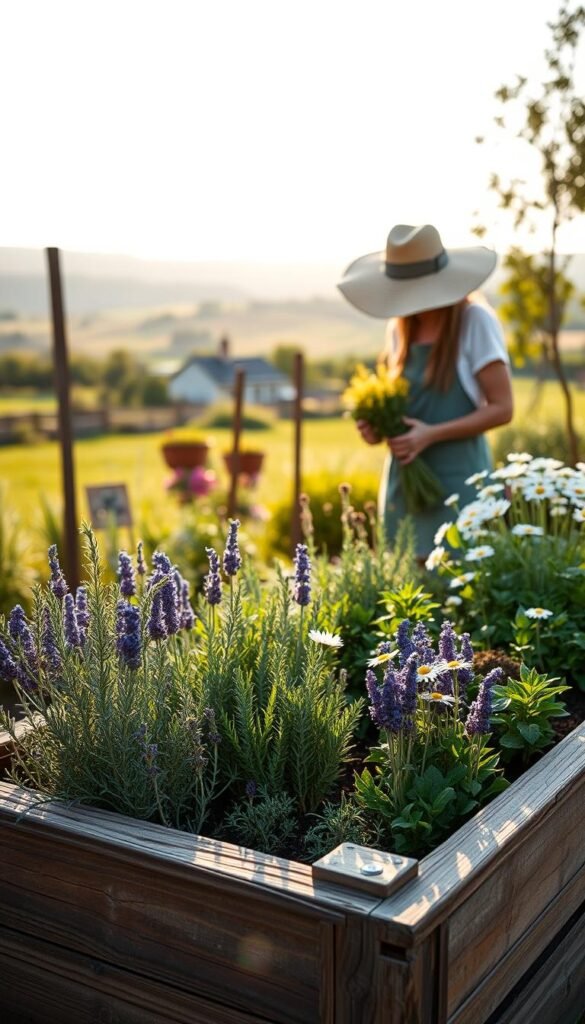
Watching tiny seeds transform into thriving plants is pure magic. Whether you’re nurturing basil on a windowsill or calendula in raised beds, these foundational skills turn hopeful starts into robust harvests.
Tips for Seed Starting and Transplanting
Some herbs practically jump from soil. Basil and dill sprout quickly from seeds, while lavender demands precise warmth and light. Start spilanthes indoors 8 weeks before frost ends—their delicate roots need protection.
Transplant on cloudy days to reduce shock. Gently loosen roots and water thoroughly. Tulsi thrives when moved outdoors after nights stay above 50°F. For no-fail container herbs, try spearmint—it stays contained and grows vigorously.
Watering, Pruning, and Pest Management
Overwatering kills more plants than drought. Check soil moisture daily—herbs prefer slightly dry conditions. Mulch with straw to retain water without soggy roots.
Pinch back leafy varieties like oregano to encourage bushiness. Let flowers bloom late in the season for pollinators. Companion planting deters pests naturally: marigolds repel nematodes, while chives keep aphids away.
| Easy From Seed | Better as Transplants | Special Care |
|---|---|---|
| Calendula | Lavender | Spearmint (containers) |
| Dill | Echinacea | Spilanthes (indoor start) |
| Basil | Peppermint | Tulsi (warm soil) |
Perennial herbs like thyme need winter protection. After first frost, trim dead growth and cover with pine boughs. They’ll reward you with fresh sprouts next year.
Incorporating Permaculture and Sustainability in Your Garden
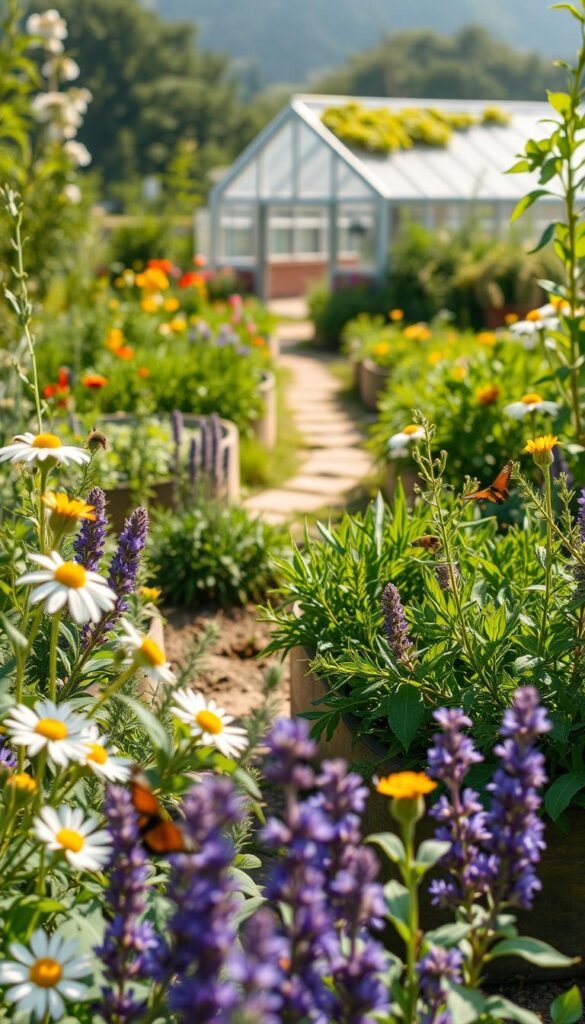
Your garden becomes a living classroom when you partner with nature’s cycles. At Wild Moon Acres, gardeners fill raised beds with fallen leaves and decomposing wood before adding soil. This clever way to recycle yard waste feeds plants for years as materials break down.
Using Organic Matter and Natural Fertilizers
Kitchen scraps and autumn leaves transform into gold for your herbs. Mix coffee grounds with crushed eggshells to boost calcium levels naturally. These free amendments create richer earth than store-bought bags—plus, they align with organic gardening basics.
Try this soil-building recipe from seasoned growers:
| Material | Benefit | Decomposition Time |
|---|---|---|
| Fallen leaves | Adds carbon | 6-12 months |
| Wood chips | Improves drainage | 1-2 years |
| Grass clippings | Boosts nitrogen | 3-6 weeks |
Save seeds from your healthiest mint or calendula to grow herbal champions adapted to your microclimate. Connect with local enthusiasts through plant swaps—Mountain Rose Herbs also offers rare varieties for mail-order.
Position water-loving lemon balm near downspouts, while drought-resistant thyme thrives on slopes. This thoughtful placement mimics natural ecosystems, creating a self-sustaining gardening space that doubles as a wildlife haven.
Harvesting and Using Your Medicinal Herbs
Your thriving garden now offers more than beauty—it’s time to unlock its full healing potential. Timing matters when gathering nature’s gifts, and simple techniques preserve their strength. Let’s turn those vibrant leaves and flowers into remedies that stock your home apothecary.
Perfect Timing for Peak Potency
Snip leaves like rosemary in mid-morning after dew evaporates. Their aromatic oils peak before afternoon heat. For calendula flowers, harvest when petals fully open—daily picking encourages new blooms. Always use sharp scissors to avoid crushing delicate stems.
Crafting Kitchen Counter Cures
Dry chamomile flowers on screens for sunny-day tea. Infuse fresh mint leaves in honey for sore throats. Try this quick salve: melt beeswax with calendula oil, pour into tins, and cool. Your first-aid kit just leveled up!
Nibble tulsi leaves straight from the plant for stress relief. Steep spilanthes buds in vodka for two weeks to make tingling mouthwash. With these recipes, every harvest becomes medicine you crafted yourself—the ultimate homegrown wellness.

